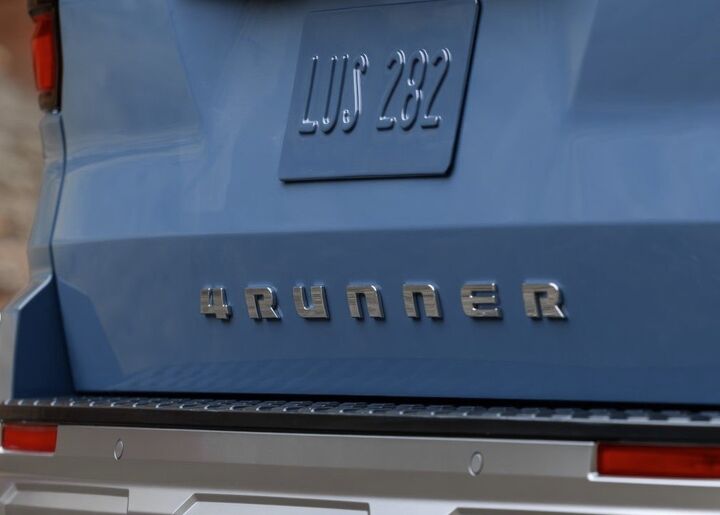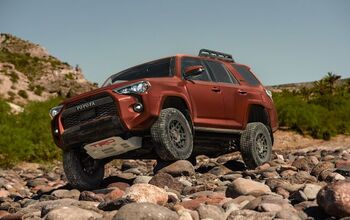2025 Toyota 4Runner Officially Teased

Toyota has officially previewed the redesigned 4Runner for the first time via Instagram. But the photo in question doesn’t offer much information beyond the model wearing its name at the bottom of the rear hatch and getting some new taillights. There’s likewise a contrasting bumper, which may just end up being an option. However, Toyota offering up a teaser for the 2025 model year should also indicate that the much-anticipated SUV’s formal debut is likely right around the corner.
A new 4Runner is a pretty big deal, as it’s one of those Toyota products with incredibly loyal customers and an extremely long lifecycle. The last time we saw an entirely new example of the model was 2009. While reviewers have started to bemoan the SUV as feeling quite dated, there’s a reason the manufacturer has been hesitant to issue an update.
Toyota fans come in a variety of flavors. But the convictions of the truly faithful often stem from prior ownership of a Toyota product that simply refused to succumb to old age. While this has helped a brand that primarily manufacturers comparatively basic vehicles develop a die-hard fanbase, it also makes every it a minor gamble whenever it deploys new technologies or decides to issue a redesign. In fact, the company itself is notoriously adverse to making sweeping changes for this very reason. Toyota is absolutely obsessed with quality control because it knows its customers have emotional attachments to vehicles that are often decades old.
That logic certainly doesn’t apply to all Toyota models, especially those that have proven to be no-more reliable than what’s available from its rivals. But it does apply to models like the Camry, Corolla, Highlander, and 4Runner.
While your author has seen a prototype of the new 4Runner in the wilds near Toyota’s R&D center, the vehicle itself remains a mystery due to the fact that it was heavily camouflaged. But the vehicle will clearly continue boasting lofty approach and departure angles with plenty of ground clearance. Platform sharing with the current Tacoma pickup also appears to be a given, though that’s based more on assumptions and leaks coming from within the company.
Assuming the Tacoma relationship is maintained, it’s assumed that a turbocharged 2.4-liter four-cylinder engine (offering somewhere in the neighborhood of 250 horsepower) will be the base powertrain. A substantially more powerful hybrid variant is presumed for higher trims. All-wheel drive is assured. But which nifty off-road features that accompany the system will be determined by trim levels.
The SUV is supposed to be revealed later this year and the teaser would suggest that date is coming sooner than later. The starting MSRP is assumed to ballpark somewhere around $42,000.
[Images: Toyota]
Become a TTAC insider. Get the latest news, features, TTAC takes, and everything else that gets to the truth about cars first by subscribing to our newsletter.

A staunch consumer advocate tracking industry trends and regulation. Before joining TTAC, Matt spent a decade working for marketing and research firms based in NYC. Clients included several of the world’s largest automakers, global tire brands, and aftermarket part suppliers. Dissatisfied with the corporate world and resentful of having to wear suits everyday, he pivoted to writing about cars. Since then, that man has become an ardent supporter of the right-to-repair movement, been interviewed on the auto industry by national radio broadcasts, driven more rental cars than anyone ever should, participated in amateur rallying events, and received the requisite minimum training as sanctioned by the SCCA. Handy with a wrench, Matt grew up surrounded by Detroit auto workers and managed to get a pizza delivery job before he was legally eligible. He later found himself driving box trucks through Manhattan, guaranteeing future sympathy for actual truckers. He continues to conduct research pertaining to the automotive sector as an independent contractor and has since moved back to his native Michigan, closer to where the cars are born. A contrarian, Matt claims to prefer understeer — stating that front and all-wheel drive vehicles cater best to his driving style.
More by Matt Posky
Latest Car Reviews
Read moreLatest Product Reviews
Read moreRecent Comments
- W Conrad I'm not afraid of them, but they aren't needed for everyone or everywhere. Long haul and highway driving sure, but in the city, nope.
- Jalop1991 In a manner similar to PHEV being the correct answer, I declare RPVs to be the correct answer here.We're doing it with certain aircraft; why not with cars on the ground, using hardware and tools like Telsa's "FSD" or GM's "SuperCruise" as the base?Take the local Uber driver out of the car, and put him in a professional centralized environment from where he drives me around. The system and the individual car can have awareness as well as gates, but he's responsible for the driving.Put the tech into my car, and let me buy it as needed. I need someone else to drive me home; hit the button and voila, I've hired a driver for the moment. I don't want to drive 11 hours to my vacation spot; hire the remote pilot for that. When I get there, I have my car and he's still at his normal location, piloting cars for other people.The system would allow for driver rest period, like what's required for truckers, so I might end up with multiple people driving me to the coast. I don't care. And they don't have to be physically with me, therefore they can be way cheaper.Charge taxi-type per-mile rates. For long drives, offer per-trip rates. Offer subscriptions, including miles/hours. Whatever.(And for grins, dress the remote pilots all as Johnnie.)Start this out with big rigs. Take the trucker away from the long haul driving, and let him be there for emergencies and the short haul parts of the trip.And in a manner similar to PHEVs being discredited, I fully expect to be razzed for this brilliant idea (not unlike how Alan Kay wasn't recognized until many many years later for his Dynabook vision).
- B-BodyBuick84 Not afraid of AV's as I highly doubt they will ever be %100 viable for our roads. Stop-and-go downtown city or rush hour highway traffic? I can see that, but otherwise there's simply too many variables. Bad weather conditions, faded road lines or markings, reflective surfaces with glare, etc. There's also the issue of cultural norms. About a decade ago there was actually an online test called 'The Morality Machine' one could do online where you were in control of an AV and choose what action to take when a crash was inevitable. I think something like 2.5 million people across the world participated? For example, do you hit and most likely kill the elderly couple strolling across the crosswalk or crash the vehicle into a cement barrier and almost certainly cause the death of the vehicle occupants? What if it's a parent and child? In N. America 98% of people choose to hit the elderly couple and save themselves while in Asia, the exact opposite happened where 98% choose to hit the parent and child. Why? Cultural differences. Asia puts a lot of emphasis on respecting their elderly while N. America has a culture of 'save/ protect the children'. Are these AV's going to respect that culture? Is a VW Jetta or Buick Envision AV going to have different programming depending on whether it's sold in Canada or Taiwan? how's that going to effect legislation and legal battles when a crash inevitibly does happen? These are the true barriers to mass AV adoption, and in the 10 years since that test came out, there has been zero answers or progress on this matter. So no, I'm not afraid of AV's simply because with the exception of a few specific situations, most avenues are going to prove to be a dead-end for automakers.
- Mike Bradley Autonomous cars were developed in Silicon Valley. For new products there, the standard business plan is to put a barely-functioning product on the market right away and wait for the early-adopter customers to find the flaws. That's exactly what's happened. Detroit's plan is pretty much the opposite, but Detroit isn't developing this product. That's why dealers, for instance, haven't been trained in the cars.
- Dartman https://apnews.com/article/artificial-intelligence-fighter-jets-air-force-6a1100c96a73ca9b7f41cbd6a2753fdaAutonomous/Ai is here now. The question is implementation and acceptance.



































Comments
Join the conversation
It's one thing to stay tried and true to loyal past customers; you'll ensure a stream of revenue from your installed base- maybe every several years or so.
It's another to attract net-new customers, who are dazzled by so many other attractive offerings that have more cargo capacity than that high-floored 4-Runner bed, and are not so scrunched in scrunchy front seats.
Like with the FJ Cruiser: don't bother to update it, thereby saving money while explaining customers like it that way, all the way into oblivion. Not recognizing some customers like to actually have right rear visibility in their SUVs.
I suppose we will have another few dozen Teeyoda Foreskin spy shots coming.